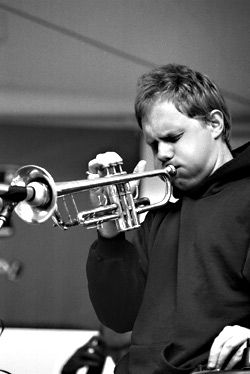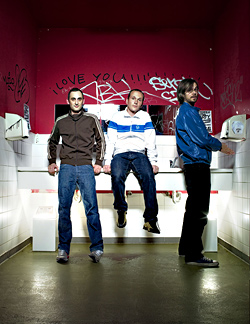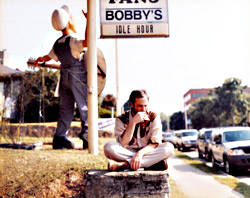Laptops and synthesizers play call-and-response with hiccupping sax, deep breaths of silence, and shouted non sequiturs. A foley artist mimics horse hooves with the patter of metal on concrete as a classically trained violist reinterprets the Delta blues. A turntable and the spokes of a bicycle wheel play a duet. It sounds like a Fluxus convention, but what is that racket?
Maybe the best thing about the 21st annual Seattle Improvised Music Festival (SIMF) is that the performers themselves don’t always know the answer to that, either. Held at Gallery 1412 Wednesday, Feb. 8, to Sunday, Feb. 12, SIMF celebrates intuition and invention, the key elements of nonidiomatic music, invoking the theatrical spirit of Stockhausen and the mystery of last week’s Lost, sometimes on a MacGyver budget. In a festival-heavy city like Seattle, even the most beloved and wide-ranging fetes can be a bit predictable. Here, the idea is to shake things up not just during booking but while onstage as well.
Improvisation can sometimes seem like the province of beard-strokers and academics, but its performers are just as inspired by textual forms and ephemera—from a wire whisk to the wife’s earrings or an old snapshot—adding an unexpected turn to performance. This year, the festival’s basis is collaboration, with curator Gust Burns pairing many of the performing combos for the first time. “[SIMF] is artist run,” Burns explains via e-mail. “I get to use my insights as an artist . . . to program a festival that is interesting in terms of overall aesthetic direction and collaborative potential.”
Unexpected pairings may leave the artist as surprised as the viewer. Waiting patiently for an introduction can be part of the act.
At its inception in 1985, SIMF focused on new groupings; more recently, it’s tended to showcase recognized ensembles and soloists, such as composer Pauline Oliveros and Seattleites—and former curators—Bill Horist and Wally Shoup. This year, the focus is on new performers who, Burns explains, are interested in developing relationships with Seattle-based improvisers. “There is often an urgency or edge to the music made by people who haven’t been accepted by the dominant cultural gatekeepers associated with improvised music—academia and music festivals.”
Unexpected pairings may leave the artist as surprised as the viewer. Waiting patiently for an introduction can be part of the act. “There are two ‘typical’ ways to start a piece in improvised music,” says Mike Bullock, a Bostonian who plays prepared amplified cello and surface electronics with bassist Vic Rawlings Sunday afternoon. “One is shy, where people start to creep in with little constipated sounds; and one is the opposite, where someone—or everyone—jumps in with something bold. I like to take a moment of silence before a piece starts, just so you know that the conversation and warming-up stage is over, and then let people enter as if the piece has already started, so no one has to feel excessive pressure to do one or another kind of starting thing.”
What are the parameters of a performance that can include basically anything a musician walks in with? “When I do workshops, sometimes I start with [a] constraint,” Burns explains. “Each improviser will play only one sustained sound—it can last from five to 30 seconds. The entire piece will last two minutes. Each improviser can place his/her sound anywhere in [that] two minutes. This puts the focus on placement of sound, and also introduces a way of thinking about the sounds as ‘objects’ that can be placed repeatedly.”
Last year, SIMF began a free, open-to- the-public improvisation workshop; this Saturday afternoon, bassist Rawlings will instruct musicians and vocalists of all levels. The focus, says Burns, will be on making music as “sound,” rather than thinking about melody, harmony, and rhythm. Rawlings will also lead a cadre of performers on the last day of the festival and perform with fellow Bostonian Bullock. The duo’s screeches and ambling blips are straight out of David Lynch—if the mercurial filmmaker remade Close Encounters of the Third Kind.
Amidst the seemingly haphazard rattle and hum, a clean set of ears is crucial. “You have to know when the music has left the room, and that depends on how well you listen,” says San Francisco saxophonist Phillip Greenlief, a West Coast improv fixture since the late ’70s, most recently alongside cellist/vocalist/bicycle wheel–player Theresa Wong. Greenlief is philosophical about the partnership. “A group could last a month, or in some cases, you might play with a group for 15 years and still have a lot to explore,” he says. “You have to listen to ‘the group’ in the same way you listen while improvising—hear the cadence that guides your ears to silence.”
Silence, it would seem, is a major tenet of improvisation. It’s usually quiet enough in the Gallery to mistake audience rustling with whatever is happening onstage. Los Angeles’ David Kendall, an electronics musician who with cellist Jessica Catron and laptop artist David Rothbaum forms the Tights Band, creates what you might think of as a prepared score for an unrealized film script. Kendall’s solo compositions intersperse a fluid line of feedback with hiccups of glitch, filling in the backstory. He counts chemistry, timbre, and time among the key ingredients for a strong partnership. “[It’s] an interesting combination of sounds that has not been overdone, improvisers with similar goals—though not necessarily similar styles—and time for the relationship to develop,” he says. “Every project that I have ever been involved with gets more rewarding with the time devoted to it.”
Recorded material, like live performance, rewards those who are patient. Burns and bassist Andrew Lafkas enjoy the silence on their minimalist Naked as the Sucklings (released on Burns’s Tone Action Family label), but there’s also just enough movement filtering through the first three minutes to ensure you aren’t listening to a dummy recording. Likewise, the work of Lisbon-based duo Ernesto Rodrigues (viola) and Manuel Mota (guitar) begins with brief chatter or strings and rings, and swells to a rich musical conversation.
If these kinds of works help engender dialogue, they also lead to another, just as fruitful kind. “Making connections so [that] touring and visiting other parts of the country and world are more possible,” says Burns. “Networking— in terms of organizing—is part of the collaborative element.”
Seattle Improvised Music Festival takes place Wed., Feb. 8–Sun., Feb. 12, at Gallery 1412. See Seven Nights (p. 55) and www.seattleimprovisedmusic.com for more details.








